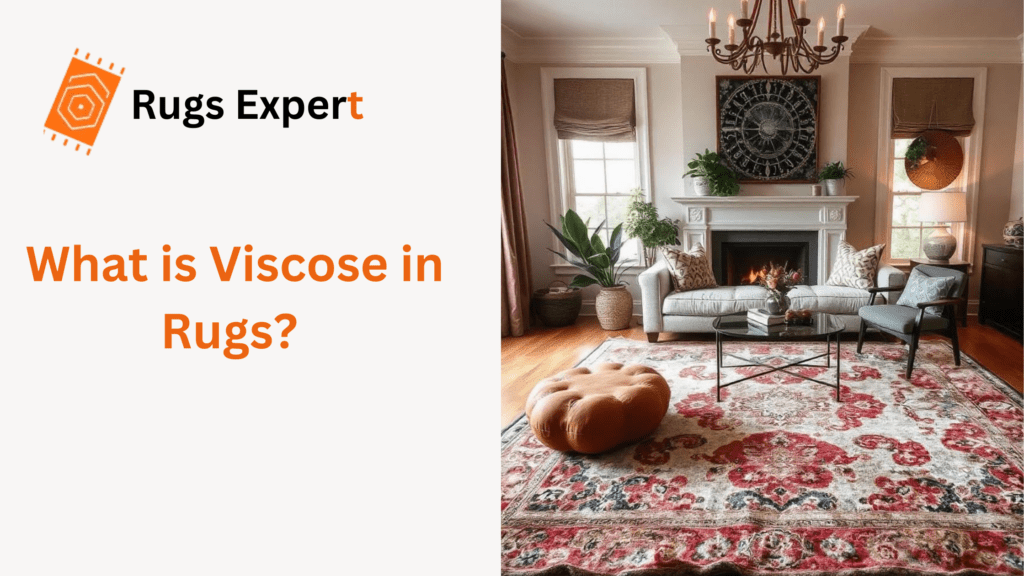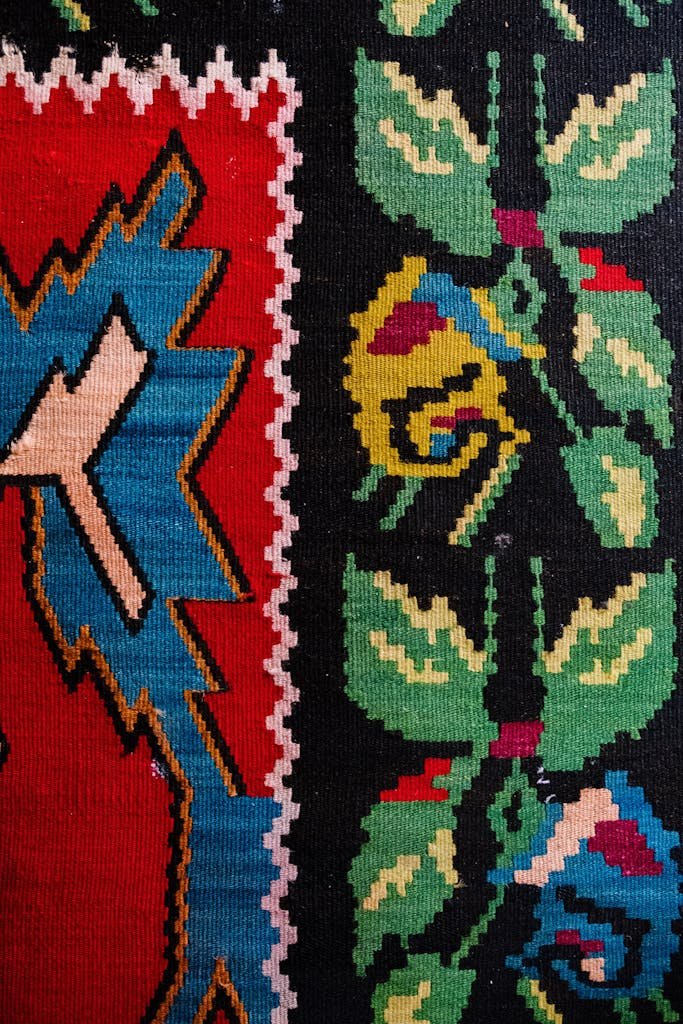
Ever walked into a room and been instantly captivated by a rug that seemed to shine? Chances are, you’ve met a viscose rug. But what exactly is viscose, and why is it becoming increasingly popular in the world of floor coverings?
Let’s dive into the fascinating world of viscose rugs and reveal the mystery behind this lustrous material.
A Brief Overview of Viscose
Viscose, also known as artificial silk, is a man-made fiber that’s been turning heads in the textile industry for decades. It’s got the charm of natural fibers with the consistency of synthetic ones talk about the best of both worlds!
Importance in Rug Manufacturing
In recent years, viscose has become a go-to material for rug manufacturers looking to create eye-catching, affordable pieces that copy the luxurious look of silk. It’s no wonder that viscose rugs are popping up in homes, offices, and hotels around the world.
What is Viscose in Rugs?
Before understanding the task of viscose in the rug, it is important to know its material.
Definition of Viscose
So, what exactly is viscose? In simple terms, it’s recreated cellulose fiber. Now I know that sounds like a mouthful, but stick with me here. Essentially, it’s a fiber made from natural materials usually wood pulp that undergoes a chemical process to create a silky, smooth texture.
Historical Background

Viscose has an ancient history. It was first developed in the late 19th century as an alternative to silk. Can you imagine the excitement when scientists figured out how to create a silk-like material without relying on silkworms? It was revolutionary!
Manufacturing Process
The process of creating viscose is a bit like cooking up a scientific potion. It starts with dissolving cellulose, usually wood pulp, in a chemical solution. This creates a viscous liquid (hence the name “viscose”) that’s then forced through tiny holes into an acid bath.
As if by magic, the liquid gets solidified after a long time, forming continuous fibers that can be spun into yarn. Pretty cool, right?
Viscose in Rug Production
Let’s understand the use of viscose in the rug-making process.
Why Viscose is Used in Rugs
Now, you might be wondering, Why use viscose in rugs at all? Well, let me tell you, it’s got some pretty impressive qualities that make it perfect for creating stunning floor coverings.
Characteristics of Viscose Rugs

Viscose rugs are known for their
- Incredible shine
- Softness that rivals silk
- Ability to take on vibrant colors
- Lightweight nature
It’s like having a piece of art for your floor!
Comparison with Other Rug Materials
When you compare viscose against other rug materials, it’s easy to see why it’s gained such popularity. Compared to wool, it’s softer and has a more pronounced shine. Unlike silk, it’s much more affordable. And when you look at synthetic options like nylon or polyester, viscose offers a more natural feel and appearance.
Advantages of Viscose Rugs
Viscose has lots of advantages, let’s know them one by one:
Aesthetic Appeal
We all want our homes to look fabulous. On this front, viscose rugs really shine. Their shinier appearance can make a room look instantly more luxurious and joined. It’s like adding a touch of Hollywood glamour to your living space!
Softness and Comfort
Ever dreamed of walking on clouds? A viscose rug might be the closest you’ll get. These rugs are incredibly soft underfoot, making them a joy to walk, sit, or even lie down on. Perfect for those lazy Sunday afternoons, right?
Affordability
Here’s the real benefit, viscose rugs give you that high-end look without the high price tag. You can get the appearance of silk at a lower price. It’s like finding a designer dress at a thrift store price!
Drawbacks of Viscose Rugs
Now, I wouldn’t be giving you the full picture if I didn’t mention some of the challenges that come with viscose rugs. After all, no material is perfect.
Durability Concerns
While viscose looks amazing, it’s not the toughest kid on the block. These rugs can be prone to crushing and matting, especially in high-traffic areas. It’s a bit like having a beautiful sports car that you can only drive on Sundays.
Maintenance Challenges
Viscose and water aren’t the best of friends. When wet, viscose fibers can weaken and even break down. This means you need to be extra careful when cleaning these rugs. No soggy messes allowed!
Environmental Considerations
While viscose starts with natural materials, the manufacturing process involves chemicals that aren’t exactly eco-friendly. If you’re big on sustainability, this might give you pause for thought.
Caring for Viscose Rugs

Don’t let those cons scare you! With the right care, your viscose rug can stay beautiful for years to come.
Cleaning Techniques
The golden rule with viscose rugs? Less is more. Vacuum regularly using a suction-only setting (no beater bars, please!). For deeper cleaning, get the help of professional cleaners.
Also Read: How to Keep Rugs Looking New At Home? Easy pro Tips
Stain Removal
Spills and pet accidents are normal to happen, we’ve all been there. The key with viscose is to act fast. Blot (don’t rub!) the spill immediately with a clean, dry cloth.
For tougher stains, a mixture of mild soap and water can work wonders but remember, use it carefully!
Long-term Maintenance Tips
To keep your viscose rug looking its best:
- Rotate it regularly to ensure even wear
- Keep it out of direct sunlight to prevent fading
- Use rug pads to protect it from crushing
- Avoid placing heavy furniture on it
Treat it like the star it is, and it’ll keep shining for you!
Popular Styles of Viscose Rugs

Placing the viscose rug in the room is an art.
Traditional Designs
Viscose presents itself to make beautiful rug patterns on it. For example, Persian-inspired or classical European motifs. Viscose not only adds shine to them but also makes them feel fresh and familiar.
Modern and Contemporary Patterns
But don’t think viscose is stuck in the past! It’s home content in the form of modern rug designs, geometric patterns, and unique abstract art-inspired rugs.
Blended Viscose Rugs
Here’s where things get really interesting. Many rug makers are blending viscose with other fibers to create rugs that combine the best qualities of different materials. Viscose-wool blends, for instance, offer the durability of wool with the shine of viscose.
It’s like the superhero team-up of the rug world!
Choosing the Right Viscose Rug
Besides all of the qualities of viscose, it is important to choose the right viscose rug of the right size for your space to fully utilize its qualities.
Factors to Consider
When you’re in the market for a viscose rug, keep these points in mind:
- Traffic levels in the planned space
- Your cleaning and maintenance capabilities
- Style of your room
- Lighting conditions (remember, viscose loves to shine!)
Where to Use Viscose Rugs
Viscose rugs are perfect for:
- Formal living rooms
- Dining rooms
- Bedrooms
- Any low-traffic area where you want to make a style statement
Think of them as the special event outfit for your floors!
Budget Considerations
While viscose rugs are generally more affordable than silk, prices can vary widely based on size, design, and brand. Set a budget, but remember, a well-chosen viscose rug can be an investment in your home’s style and comfort.
Alternatives to Viscose Rugs
Everything has its alternative, so viscose, let’s know what the other options of the viscose rug are:
Natural Fiber Options
If you love the idea of viscose but want to explore other options, then:
- Silk, the original luxury fiber
- Wool, durable and naturally stain-resistant
- Cotton, easy to clean and versatile
- Jute or sisal, for a more rustic, textured look
Synthetic Alternatives
On the synthetic side, you might want to check out:
Nylon
It is a tough and easy-to-clean material, so it can be a good alternative to viscose rugs.
Polyester
It is a stain-resistant and budget-friendly material. Hence, it provides you with a good option to choose for a rug.
Polypropylene
Polypropylene is great for outdoor use. If you are planning to decorate any outdoor space, it is the best option for you.
Pros and Cons of Alternatives
Each material has its own set of advantages and challenges. Silk is luxurious but expensive. Wool is durable but can be prone to shedding. Synthetics are tough but may lack the natural feel of viscose.
It’s all about finding the right balance for your needs and preferences.
Future of Viscose in Rug Industry

As viscose gives shine to the home, its future is also shiny.
Technological Advancements
The rug industry isn’t quiet, and neither is viscose technology. Researchers are constantly working on ways to make viscose more durable and easier to maintain.
Who knows? Future viscose carpets may be almost unbreakable!
Sustainability Efforts
With growing environmental problems, many manufacturers are looking for ways to make viscose production more eco-friendly. From using sustainable wood sources to developing closed-loop production systems, the future of viscose could be much greener.
Market Trends
As consumers have become more style-conscious and budget-aware, the demand for viscose rugs is likely to grow. We might see more unique blends, new production techniques, and even more stunning designs in the future.
The future of viscose rugs looks as bright and shiny as the fibers themselves!
FAQs
Can viscose rugs be used in high-traffic areas?
While viscose rugs are beautiful, they’re not ideal for high-traffic areas. They’re best suited for low-traffic spaces like bedrooms or formal living rooms where they can be admired without excessive wear and tear.
How do I clean a viscose rug?
Viscose rugs require gentle care. Regular vacuuming with a suction-only setting is recommended. For spills, blot immediately with a clean, dry cloth. Avoid water-based cleaning methods, and consider professional cleaning for deep stains.
Are viscose rugs eco-friendly?
The eco-friendliness of viscose rugs is a complex issue. While viscose is made from natural materials (usually wood pulp), the manufacturing process involves chemicals that can be harmful to the environment. Some manufacturers are working on more sustainable production methods.
How long do viscose rugs typically last?
With proper care, a viscose rug can last several years. However, they generally don’t have the longevity of more durable materials like wool. The lifespan of your viscose rug will depend on factors like foot traffic, maintenance, and overall care.
Can viscose rugs be used outdoors?
Viscose rugs are not suitable for outdoor use. They’re sensitive to moisture and can be damaged by exposure to the elements. For outdoor spaces, consider rugs made from materials like polypropylene or treated natural fibers that can withstand outdoor conditions.
Conclusion
More than just floor coverings, viscose rugs present the creative skills of the human mind. From their silk-like shine to their soft touch, these carpets have a lot to offer to anyone willing to give them a bit extra care and attention.
Whether you’re furnishing a new home or just curious about different rug materials, viscose is definitely worth noting. It’s a material that fills the gap between natural and synthetic, offering a unique combination of beauty, softness, and affordability.
Remember, choosing a rug is about more than just picking a pretty pattern. It’s about finding a piece that fits your lifestyle and gives elegance to your space. Also, it brings you joy every time you see it.
So, the next time you’re in the market for a new rug, why not give viscose a chance? You might just find yourself walking on a little piece of everyday luxury. After all, who says you can’t have silk-like elegance without the silk-like price tag?
